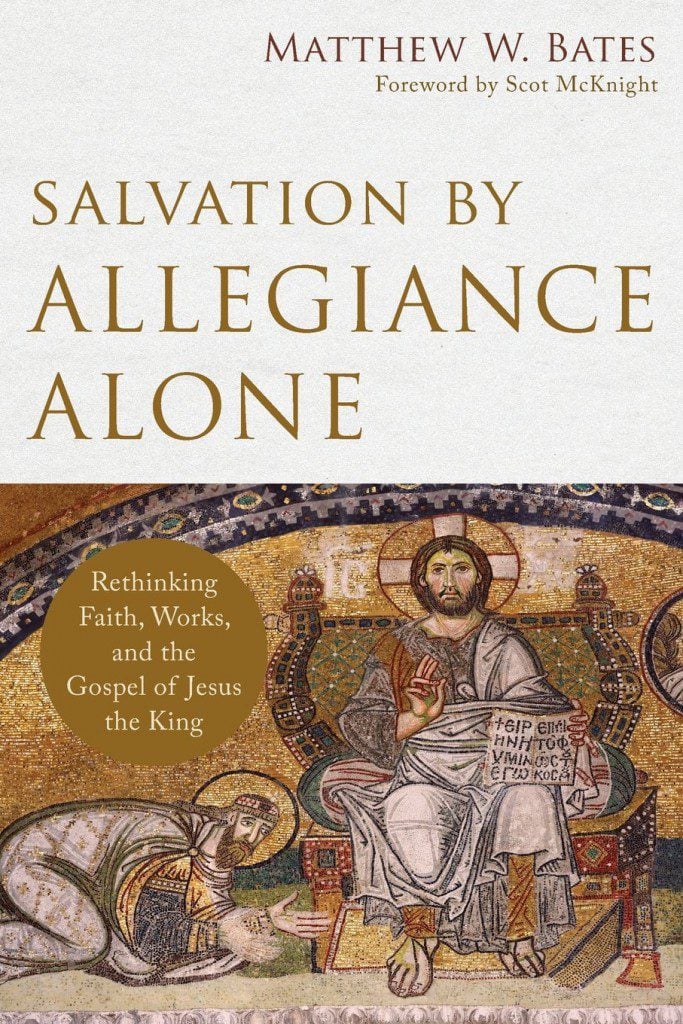This is the final post in a series of reflections sparked by Matt Bates’s new book, Salvation by Allegiance Alone. I haven’t tried in this series to provide a comprehensive overview of the book; instead I’ve shared various thoughts it has inspired. Most of these thoughts have centered around the first five chapters of the book, which explore the meaning of the word “faith” (Greek pistis) and argue that “allegiance” is the better overarching word for the concept of pistis.
More than asking broadly, “What is faith?” those first five chapters really want to answer the question, “What is saving faith?” The final four chapters step beyond this to ask – if “saving faith” is really allegiance, what does that mean for our picture of salvation? What is the purpose of allegiance – what does it lead to as its ultimate goal?
I found myself disagreeing with Bates on a number of points in these final chapters – his suggestion, for example, that in the new creation we will perfectly mirror God’s image, and an idea of justification that admirably critiques problems with the traditional Protestant and Catholic ideas of imputed merit and righteousness but does not go far enough in separating from them.
The Goal: Conjunction with God
Still, on some key points I concur with Bates in these final chapters. In the end, Bates sums up his view of the purpose of faith – which really is God’s purpose for humanity – this way:
In the gospel, God’s power to make things right is revealed, and the effects are personal, social, and cosmic. Human salvation is directed toward God’s intention to restore individuals, communities, and the world as the kingdom of God continues to break into history. When we give allegiance, we become new creatures set free from the enslaving power of sin. As we worship the Son of God, who is the authentic, original image of God, our own distorted Adamic image is transformed, so that we are personally renewed. As we are transformed into the image of Jesus the Christ, we bring God’s wise service, stewardship, and rule to one another and to the remainder of creation….
When allegiance is given to Jesus the king, God’s making all things right, his holistic salvation, moves forward, for we increasingly are able to mediate God’s presence to others and the rest of creation. It begins as individuals are united to Jesus and to one another in the church, and then it spills out to the world. (p. 203)
Compare this to the description in Divine Love and Wisdom of the purpose of creation:
The universal purpose of creation, or the purpose in all its constituents, is for an eternal conjunction of the Creator with the created universe to take place, and this is not possible without vessels in which His Divinity can exist as though in itself, thus in which it can dwell and abide. For these vessels to be His dwellings or abodes, they must be recipients of His love and wisdom as though of themselves, thus recipients which will as though of themselves elevate themselves to the Creator and conjoin themselves with Him. Without this reciprocity, conjunction is not possible.
These vessels are human beings, who are able as though of themselves to elevate and conjoin themselves. That human beings are such vessels, and that they are recipients of the Divine as though of themselves – this we have demonstrated several times above.
By that conjunction the Lord is present in every work created by Him. For everything was created ultimately for the sake of mankind. Consequently the uses of all that He created ascend by degrees from the lowest created forms to mankind, and through mankind to God the Creator from whom they originate. (§170)
Embodying the Love of God
If the goal of creation is conjunction with the Creator, then the goal of creation does not only have to do with faith – it has to do with love. One of the most foundational concepts in New Church theology is that God is love, and that as love, He wants to be conjoined with us and bless us:
It is the essence of Love to love others outside of one self, to desire to be one with them, and to render them blessed from oneself. The essence of God consists of two things, love and wisdom; while the essence of His love consists of three things, namely, to love others outside of Himself, to desire to be one with them, and from Himself to render them blessed. And because love and wisdom in God make one, the same three things constitute the essence of His wisdom; and love desires these three things, and wisdom brings them forth. (True Christian Religion §43)
Bates speaks more about enacting “wise rulership” from God than he does about love. Bu that wise rulership, of course, is an expression of love. No matter how you frame it, it’s vital to keep this at the forefront when talking about faith: the purpose of faith is that it lead to love. The well-known “love” chapter from 1 Corinthians points in this direction:
And though I have the gift of prophecy, and understand all mysteries and all knowledge, and though I have all faith, so that I could remove mountains, but have not love, I am nothing….And now abide faith, hope, love, these three; but the greatest of these is love. (1 Corinthians 13:2, 13)
The Lord’s goal is that we participate in His love. How do we do so? It’s not by trying to feel warmth and affection for Him. Instead, it is by acting in allegiance to Him. Jesus said,
“These things I have spoken to you, that My joy may remain in you, and that your joy may be full. This is My commandment, that you love one another as I have loved you. Greater love has no one than this, than to lay down one’s life for his friends. You are My friends if you do whatever I command you. (John 15:11-14)
When we act in allegiance to the Lord, we are transformed into His image and likeness. We act from His love for the human race, and in doing so, we ourselves are drawn more closely to Him, and we cooperate with drawing everyone else closer to Him. Conjunction is not just between each individual and the Lord – it is between God and His whole creation. That, I think, is the purpose of faith.
(Scripture taken from the New King James Version®. Copyright © 1982 by Thomas Nelson. Used by permission. All rights reserved.)













